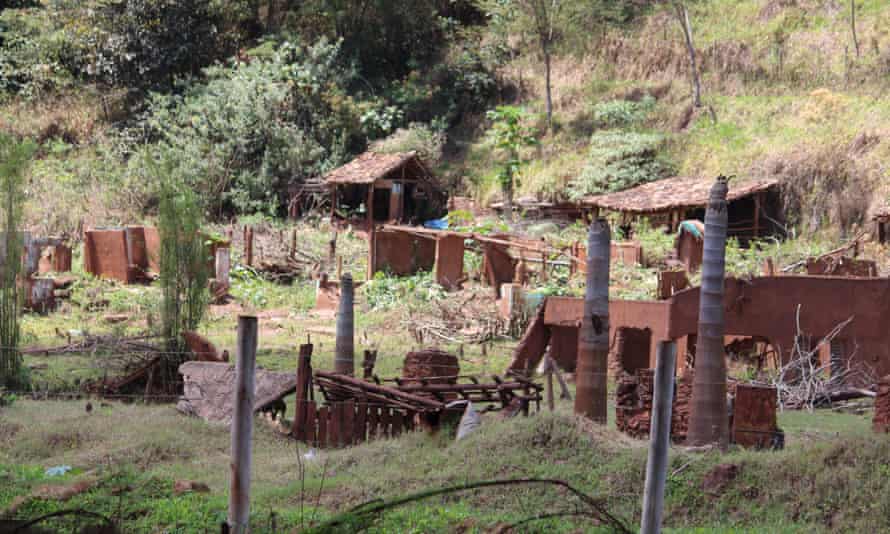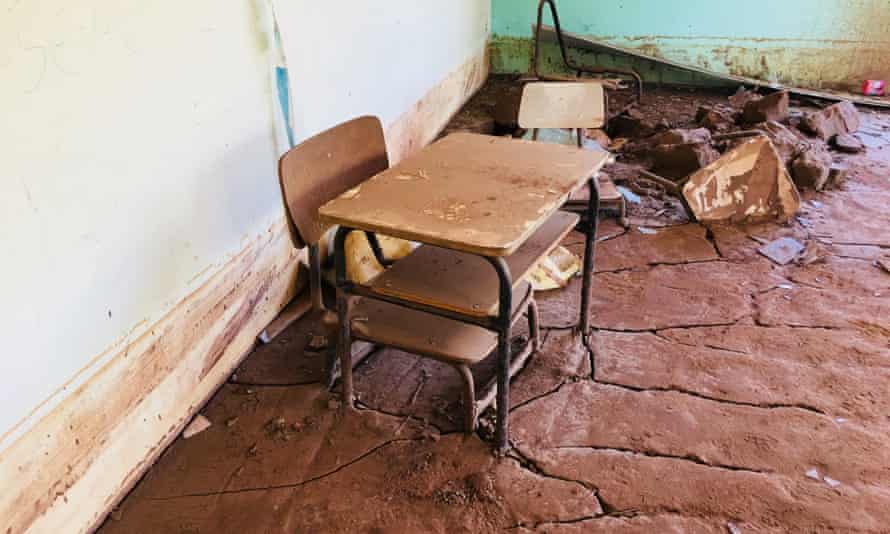he scale of what happened here begins to settle in as we pick our way through the ghost town. On the first floor of what used to be a school, more than three metres above ground level, desks and chairs poke out of caked mud at crazy angles. Hundreds of books are set into the crust, scattered amidst broken glass. Whatever happened here happened fast.
First published at the Guardian
This is not the site of a natural disaster. This is Paracatu in south-eastern Brazil, a riverside town destroyed by BHP and Vale three years ago. That would be the BHP headquartered safely ten time zones away in Melbourne, Australia.
Where we are standing is a few dozen kilometres from a collapsed iron ore mine tailings dam which disgorged up to 34 million cubic metres of mining waste into the environment in November 2015. The disaster is known as the Samarco dam collapse – after the company which is a joint venture between BHP and Vale.
The torrent of fine-grained mud killed nineteen people, wiped several townships off the map, polluted the entire stretch of the river, and then destroyed the fishing grounds on either side of the river mouth 633km downstream.
The companies claimed the mud was composed only of crushed iron ore residues and harmless silicates. A UN report immediately contradicted this information, bearing out residents’ concerns that the slurry contained toxic heavy metals and other chemicals. The truth remains contested even today, with representatives of the impacted communities unable to access reliable information about levels of toxins in the mud.
It was a disaster on an almost inconceivable scale, receiving global coverage at the time. One video of the township of Bento Rodrigues being inundated has been watched 1.7 million times. But attention fades fast in an information-saturated world – much faster than the destructive impacts.

Paracatu today, three years after the dam collapse. Photograph: Scott Ludlam
In an attempt to sidestep a decade of legal wrangling over compensation, the Brazilian federal government joined forces with authorities from the two impacted states and a dozen other agencies to sue the mining companies, reaching a US$5.2 billion settlement in March 2016.
This seemed like a relatively rapid outcome, but fault lines were already evident. In the lead-up to the settlement, federal and state prosecutors withdrew from negotiations, citing the absence of any representatives or input from the affected communities themselves. Shortly afterwards, they sued the companies for approximately US$40 billion in damages.
Faced with the financial consequences of killing whole towns and deluging a river basin with mine wastes, BHP and Vale have pursued a strategy of loss-minimisation so efficient that it challenges even the most basic conceptions of justice. Their first cut-out is to hide behind the shell of the company they each hold a 50% stake in to run their mines – Samarco – as an independently run, limited liability firm.
The second cut-out was the establishment, as part of the 2016 settlement, of the Renova Foundation to take control of the assessment and disbursement of compensation and provide a further arms-length distance to BHP and Vale. Renova is nonetheless entirely controlled by the two companies, with a handful of local representatives sidelined in advisory subcommittees that Renova quite freely ignores.
In April of 2018, Conectas, an independent human rights organisation representing the impacted communities filed an urgent appeal with, among others, the various UN Special Rapporteurs with oversight over the rights to safe drinking water, adequate housing and the rights of Indigenous peoples. The appeal document is a devastating expose of corporate malpractice.
People whose homes were buried under thousands of tonnes of mud are refused compensation unless they can produce purchase receipts of their personal belongings. People seeking to simply be formally recognised as affected are required to fill out a 600 page questionnaire.
Three years after the disaster, residents of the most impacted communities are all still living in temporary accommodation while the government dithers with construction of new settlements, and many others have found themselves pitted against corporate lawyers whose only imperative is to drive down costs: “… since the Renova Foundation and the Brazilian state have failed to provide affected communities with legal assistance, people in a situation of extreme vulnerability are reported to have paid 30% of their compensation in attorney fees”.

A classroom in Paracatu three years after the iron ore mine tailings dam collapse. Photograph: Scott Ludlam
These dismal results were predicted: a coalition of more than 100 civil society organizations and social movements condemned the ratification of the original agreement for its procedural shortcomings, most significantly the almost total absence of anyone directly representing the impacted communities.
Leticia Aleixo is a lawyer and researcher with long association with downstream Indigenous communities, for whom the disaster compounded existing struggles over land rights. “As they are traditional communities, they are very linked to the river,” she told me. “When the dam was broken the river was completely destroyed, and they still don’t have their territory recognised by the state. The thing they want the most is to have their territory recognised, as they don’t have the river any more.”
Monday will mark the third anniversary of the disaster. The sharpest questions should be levelled at the parent companies that were warned well in advance that such a disaster was a strong possibility, and the regulators that trusted the companies’ assurances that their facilities were safe.
The companies are still locked in endless legal disputes with Brazilian authorities and investors around the world,actions that could end up dragging out for years or decades. In the meantime, the greatest fear of the people subjected to the castastrophe in Brazil is that they will simply be forgotten, as the grass grows over the buried ruins of their communities.
These days, Genival Pascoal is one of the chief editors of the independent newspaper A Sirene, published out of the regional city of Mariana. Formerly, he lived in the township of Bento Rodrigues, which was completely destroyed in the tailings dam collapse. “I think that they need to sign the term of commitment on the compensation, which the Prosecutor’s office and the counselling firm put together.”
He argues for an accelerated resettlement schedule, and an economic pathway more aligned with tourism than mining. There are important questions here about the industrial world’s addiction to “extractivist” material growth that has ruined landscapes and communities from Paracatu to the Hunter Valley.
When the costs of such catastrophes can be narrowed and minimised to within a financially tolerable window, it makes repeat disasters all but inevitable.